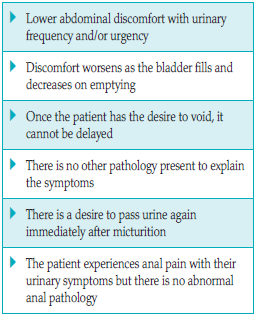References
Bogart LM. Berry SH, Clemens JQ (2007) Symptoms of interstitial cystitis, painful bladder syndrome and similar diseases in women: a systematic review. J Urol 177(2): 450–6
Chen A, Shahiyan RH, Anger JT (2022) Interstitial cystitis/bladder pain syndrome treatment: a systematic review of sexual health outcomes. Sex Med Rev 10(1): 71–6
Colaco M, Evans R (2015) Current guidelines in the management of interstitial cystitis. Transl Androl Urol 4(6): 677–83
Davis NF, Gnanappiragasam S, Thornhill JA (2015) Interstitial cystitis/painful bladder syndrome: the influence of modern diagnostic criteria on epidemiology and on Internet search activity by the public. Trans Androl Urol 4(5): 506–11
DeCaria S (2020) What is the prognosis for interstitial cystitis and lifestyle changes for it? Available online: https://www.epainassist.com/pelvic-pain/urinary-bladder/what-is-the-prognosis-for-interstitial-cystitis
French LM, Bhambore N (2011) Interstitial cystitis/painful bladder syndrome. Am Fam Physician 83(10): 1175–81
GP Notebook (2022) Interstitial cystitis (IC). Available online: https://gpnotebook.com/en-gb/simplepage.cfm?ID=-449511390
Harvard Health Publishing (2023) Treating interstitial cystitis. Available online: https://www.health.harvard.edu/a_to_z/interstitial-cystitis-a-to-z
Interstitial Cystitis Association (2015) What is Interstitial Cystitis? Available online: www.ichelp.org/about-ic/what-is-interstitial-cystitis/
Interstitial Cystitis Association (2022) What causes IC/BPS? Available online: www.ichelp.org/understanding-ic/learn-about-ic/causes/
Mayo Foundation for Medical Education and Research (2022) Interstitial cystitis. Available online: www.mayoclinic.org/diseases-conditions/intestitial-cystitis/diagnosis-treatment/drc-20354362
Mishra NN (2015) Clinical presentation and treatment of bladder pain syndrome/interstitial cystitis (BPS/IC) in India. Trans Androl Urol 4(5): 512–23
Moutzouris D-A, Falagas ME (2009) Interstitial cystitis: An unsolved enigma. Clin J Am Soc Nephrol 4(11): 1844–57
Moutzouris D-A, Vliagoftis H, Falagas ME (2008) Interstitial cystitis: an enigmatic disorder of unclear aetiology. NDT Plus 1(2): 80–4
National Institute of Diabetes and Digestive Kidney Disorders (2017) Interstitial cystitis (Painful Bladder Syndrome). Available online: www.niddk.nih.gov/health-information/urologic-diseases/interstitial-cystitis-painful-bladder-syndrome/definition-facts
National Institute for Health and Care Excellence (2019) Pentosan polysulfate sodium for treating bladder pain syndrome. Technology appraisal guidance (TA610). Available online: www.nice.org.uk/guidance/ta610
NHS (2022) Bladder pain syndrome (interstitial cystitis). Available online: https://www.nhs.uk/conditions/interstitial-cystitis/
Rovner ES (2020) Interstitial cystitis differential diagnoses. Available online: https://emedicine.medscape.com/article/2055505-differential
Tyagi P, Moon C-H, Janicki J, et al (2018). Recent advances in imaging and understanding interstitial cystitis. F1000Res 7: F1000
Tirlapur SA, Birch JV, Carberry CL, et al (2016) Management of bladder pain syndrome. BJOG 124: e46–e72
Willacy H (2021) Interstitial cystitis. Painful bladder syndrome. Available online: https://patient.info/kidney-urinary-tract/painful-bladder-syndrome-interstitial-cystitis#nav-5
Urology Foundation (2022) Interstitial cystitis. Available online: https://www.theurologyfoundation.org/urologyhealth/bladder/intertitial-cystitis
Chen A, Shahiyan RH, Anger JT (2022) Interstitial cystitis/bladder pain syndrome treatment: a systematic review of sexual health outcomes. Sex Med Rev 10(1): 71–6
Colaco M, Evans R (2015) Current guidelines in the management of interstitial cystitis. Transl Androl Urol 4(6): 677–83
Davis NF, Gnanappiragasam S, Thornhill JA (2015) Interstitial cystitis/painful bladder syndrome: the influence of modern diagnostic criteria on epidemiology and on Internet search activity by the public. Trans Androl Urol 4(5): 506–11
DeCaria S (2020) What is the prognosis for interstitial cystitis and lifestyle changes for it? Available online: https://www.epainassist.com/pelvic-pain/urinary-bladder/what-is-the-prognosis-for-interstitial-cystitis
French LM, Bhambore N (2011) Interstitial cystitis/painful bladder syndrome. Am Fam Physician 83(10): 1175–81
GP Notebook (2022) Interstitial cystitis (IC). Available online: https://gpnotebook.com/en-gb/simplepage.cfm?ID=-449511390
Harvard Health Publishing (2023) Treating interstitial cystitis. Available online: https://www.health.harvard.edu/a_to_z/interstitial-cystitis-a-to-z
Interstitial Cystitis Association (2015) What is Interstitial Cystitis? Available online: www.ichelp.org/about-ic/what-is-interstitial-cystitis/
Interstitial Cystitis Association (2022) What causes IC/BPS? Available online: www.ichelp.org/understanding-ic/learn-about-ic/causes/
Mayo Foundation for Medical Education and Research (2022) Interstitial cystitis. Available online: www.mayoclinic.org/diseases-conditions/intestitial-cystitis/diagnosis-treatment/drc-20354362
Mishra NN (2015) Clinical presentation and treatment of bladder pain syndrome/interstitial cystitis (BPS/IC) in India. Trans Androl Urol 4(5): 512–23
Moutzouris D-A, Falagas ME (2009) Interstitial cystitis: An unsolved enigma. Clin J Am Soc Nephrol 4(11): 1844–57
Moutzouris D-A, Vliagoftis H, Falagas ME (2008) Interstitial cystitis: an enigmatic disorder of unclear aetiology. NDT Plus 1(2): 80–4
National Institute of Diabetes and Digestive Kidney Disorders (2017) Interstitial cystitis (Painful Bladder Syndrome). Available online: www.niddk.nih.gov/health-information/urologic-diseases/interstitial-cystitis-painful-bladder-syndrome/definition-facts
National Institute for Health and Care Excellence (2019) Pentosan polysulfate sodium for treating bladder pain syndrome. Technology appraisal guidance (TA610). Available online: www.nice.org.uk/guidance/ta610
NHS (2022) Bladder pain syndrome (interstitial cystitis). Available online: https://www.nhs.uk/conditions/interstitial-cystitis/
Rovner ES (2020) Interstitial cystitis differential diagnoses. Available online: https://emedicine.medscape.com/article/2055505-differential
Tyagi P, Moon C-H, Janicki J, et al (2018). Recent advances in imaging and understanding interstitial cystitis. F1000Res 7: F1000
Tirlapur SA, Birch JV, Carberry CL, et al (2016) Management of bladder pain syndrome. BJOG 124: e46–e72
Willacy H (2021) Interstitial cystitis. Painful bladder syndrome. Available online: https://patient.info/kidney-urinary-tract/painful-bladder-syndrome-interstitial-cystitis#nav-5
Urology Foundation (2022) Interstitial cystitis. Available online: https://www.theurologyfoundation.org/urologyhealth/bladder/intertitial-cystitis



.png)
.png)
.png)
